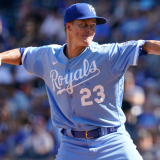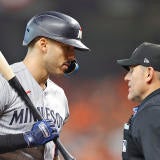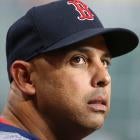
The Red Sox decided on their new manager on Friday; it's Alex Cora, the same Alex Cora who had served as Boston's manager until January, when he was dismissed because of his involvement in the Houston Astros' sign-stealing scandal. The Red Sox, of course, were later punished for their own technological misconduct. Major League Baseball's investigation concluded that Cora was not involved in that particular scheme, and that was evidently good enough for the organization to welcome him back into their waiting arms.
It stands to reason that Cora's appointment is a hint that the Red Sox intend to try harder next season. They're coming off an abysmal 2020 that saw them finish last in the American League East and post their worst winning percentage since the 1930s. After all, if the Red Sox were committed to a long-term rebuild, then they could've hired someone else to babysit.
So what can and should the Red Sox do this winter to improve their chances of competing again? Here are three steps we think they'll consider.
1. Resolve the Pedroia situation
Second baseman Dustin Pedroia deserves his flowers for a decorated career that saw him accumulate more than 50 Wins Above Replacement and partake in three championship seasons (albeit barely in '18). Unfortunately, health woes have limited Pedroia to nine appearances over the past three years. There's a season remaining on Pedroia's contract, and according to the Boston Globe's Peter Abraham, the two sides are "prepared to talk soon" about what comes next.
"What comes next" is likely to be straightforward: the Red Sox will release Pedroia with an agreed-upon payment schedule for the $12 million he's owed. In turn, the Red Sox will free up a spot on their 40-player roster that would have been occupied during the winter. Though that may seem like a relatively small development, it allows the Red Sox to sign an additional free agent; acquire an additional big-league piece through a trade or a waiver claim; or, even, to protect another player from the Rule 5 draft that they wouldn't have been able to otherwise.
These days, teams treat 40-man roster spots as their own precious, finite commodity; it's no wonder, then, why the Red Sox are likely to seek an agreement with Pedroia.
2. Raid the pitching market
Taking advantage of a frosty pitching market might be the second point here, but it should be Boston's priority. The Red Sox are projected to have an Opening Day payroll around $122 million, some $64 million below what they would've spent this year, according to Cot's Contracts. Even if Boston takes a conservative fiscal approach in response to the pandemic, they should have ample wiggle room to add several pieces to one of the majors' worst pitching staffs.
Chris Sale underwent Tommy John surgery in March, so it's unrealistic to expect him to be back before the season is well underway. Eduardo Rodriguez, meanwhile, continues to recover from the myocarditis he developed after contracting COVID-19. His status for Opening Day is less important than him being able to resume a normal, healthy everyday life.
If those two are out of the picture, that leaves the Red Sox with a rotation comprising Nathan Eovaldi (who was floated in bad-contract-swaps at the deadline and will likely be subject to those talks again this winter); Nick Pivetta; Tanner Houck; and perhaps someone like Connor Seabold, one of Boston's prized deadline acquisitions. Clearly, then, the Red Sox need help.
That help is unlikely to arrive in the form of Trevor Bauer or Marcus Stroman. There are any number of mid-to-back-end options who could make sense for the Red Sox. Consult our top-60 list, for example, and you'll find the following starting pitchers ranked 30th or below:
No. 30 Corey Kluber
No. 52 Jose Quintana
No. 53 Trevor Cahill
No. 54 Drew Smyly
No. 56 Robbie Ray
The odds are in favor of the Red Sox being able to net one, two, or maybe even three pitchers on or around that tier on reasonable one-year deals. Now, granted, there are risks associated with each of those pitchers -- be them health, performance, or some combination thereof -- but it sure beats having to trot out Zack Godley and others who failed to get the job done in 2020.
A similar approach can be taken in addressing Boston's bullpen, which ought to return Matt Barnes, Ryan Brasier, and a couple others who have shown signs of being worthwhile big-league relievers. Again, Boston doesn't have to swing big for a Liam Hendriks or a Brad Hand to make an upgrade. Here is the same exercise as above, except with relief pitchers:
No. 34 Pedro Baez
No. 35 Alex Colome
No. 36 Blake Treinen
No. 37 Trevor May
No. 38 Trevor Rosenthal
No. 46 Shane Greene
No. 47 Mark Melancon
No. 48 Kirby Yates
No. 49 Ken Giles
No. 57 Yusmeiro Petit
No. 58 Tyler Clippard
No. 59 Tony Watson
No. 60 Anthony Bass
There's no justification or excuse for the Red Sox to enter next spring without an improved pitching staff in tow -- not if they intend to field a better product in 2021, anyway.
3. Hope for some key bouncebacks
While Bloom will need to make a few adjustments to his lineup -- namely in center field (Jackie Bradley Jr. is a free agent) and second base -- what he needs more is beyond his control: rebound efforts from designated hitter J.D. Martinez and outfielder Andrew Benintendi.
Martinez, who was unhappy with the league's pandemic-inspired restricted video access this season, hit just seven home runs and posted an 81 OPS+ -- marks well below his norm. Beintendi, meanwhile, hit .103/.314/.128 (27 OPS+) before his season ended after 14 games. The Red Sox aren't likely to replace either Martinez or Benintendi, meaning the best route forward is to work with them so that they can get back on track.
If the Red Sox can achieve that feat (boosting their 12th-ranked offense) while adding outside pitching talent, then perhaps Cora's won't be the only return to Boston in 2021; perhaps the idea of competing for a playoff spot will be back, too.






















